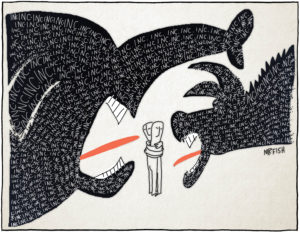A Case Study in the Perverse Incentives Tobacco Bonds Create
A central tenet of government finance is that money borrowed over the long term should be spent on projects that will outlast the debt – things like buildings, bridges or other essential infrastructure. That's not what upstate New York's Niagara County did with much of its money from tobacco bonds. Shutterstock
Shutterstock
By Cezary Podkul, ProPublicaThis piece originally ran on ProPublica.
A central tenet of government finance is that money borrowed over the long term should be spent on projects that will outlast the debt – things like buildings, bridges or other essential infrastructure.
That’s not what upstate New York’s Niagara County did with much of its money from tobacco bonds.
Golf carts. Computers. Defibrillators. Portable radios. Even a grease trap for the jail’s kitchen. The list of goods or projects with just a few years’ useful life goes on – all paid for with debt that will last decades.
Nor did the money go toward the health care costs of smoking – as hoped by framers of the 1998 legal settlement with tobacco companies that has paid billions to states, counties and other governments.
Since then, Niagara County repeatedly borrowed against its share of the settlement, about $3.5 million a year. For some of this debt, it borrowed at nearly 8 percent interest and used the proceeds to pay down debts charging half as much.
Niagara’s experience shows how “securitizing” the tobacco money – and the windfall of upfront cash it puts at politicians’ disposal – creates pressure to spend quickly and with less regard to long-term costs.
It also highlights a weakness in IRS rules, which are meant to rein in the use of long-term, tax-exempt debt for items with a short, useful life but still allow many to slip through.
How It All Started
When Niagara issued its first tobacco bonds in October 2000, it gave up 100 percent of the payments it was receiving from the settlement in exchange for $48 million in upfront cash, before fees and reserves.
Nearly half was used to repay debts for past projects, mainly a jail expansion. Niagara’s legislators set aside most of the remainder, $19 million, for capital projects in keeping with the life of the bonds, which had maturities of up to 40 years.
William Ross, then a member and now chairman of the county legislature, said the aim was to catch up on needs that Niagara had postponed because it spent so much on Medicaid, including paying for sick smokers. Reimbursing those costs was one reason for the tobacco settlement.
“People sometimes ask, ‘Well, how come counties got part of the settlement money?’ Because we were so far behind on projects,” Ross said. “And some of those were what I call ‘pretty good projects.'”
ProPublica reviewed 50 pages of spending resolutions related to the county’s tobacco bond proceeds.
The biggest capital outlay was $2.8 million to build a new emergency services training facility that today serves as a command hub for first responders. “It’s definitely well worth the money spent and has very positively impacted the county,” Jonathan Schultz, Niagara’s director of emergency management, said during a tour.
Legislators also OK’d about $4.3 million for road and bridge projects, $3.8 million for various building improvements, and $1 million for a health education center at the local community college.
But most of the resolutions covered routine spending for relatively short-lived equipment that could have easily been financed from the annual settlement payments without borrowing.
The first such resolution approved $250,000 for sprinklers at the county-owned golf course – on top of $500,000 spent to pay off earlier debt for the course irrigation system. Some $60,000 went for computers, $100,000 for defibrillators, $42,000 for portable radios and $50,000 for the jail’s grease trap.
In an interview at the jail, Chief Deputy Sheriff Thomas Beatty flipped through the stack of resolutions alongside a reporter. The defibrillators and radios were obsolete, he said, though the grease trap was still doing its job, as was a $50,000 loading ramp to the kitchen.
Referring to $175,000 authorized to buy out leases on sheriff’s cars, he said: “Obviously, these vehicles would have been long gone by now.”
A rubber tire grinder for the county landfill also made the cut. Niagara shelled out $459,200 of the tobacco bond proceeds for it in 2001, according to the county’s public information officer. In May, it was auctioned off online for $74,300.
At one point, legislators considered buying themselves $3,500 laptops, but then balked, the Buffalo News reported. And after the county approved $201,000 in tobacco bond money to buy 60 golf carts in 2001, even lobbyists at R.J. Reynolds Tobacco emailed around a copy of a story about the purchase.
The lone smoking-related resolution – allocating $5,000 to enforce a state anti-smoking law – was paid for with money from fines. In 2013, Niagara did spend about $56,000 on smoking prevention, but funding mainly came from state and federal grants, not tobacco bond proceeds.
Niagara officials didn’t respond to requests for comment on how they spent their tobacco bond money.
Lenient IRS Rules
Anti-smoking groups say securitization has turned out to be good news for R.J. Reynolds and the other major cigarette makers contributing to the settlement.
In part, that’s because of IRS rules. To qualify as tax exempt, the bond proceeds must generally be spent for debt repayment or long-term projects. Smoking prevention programs don’t qualify as either.
“They could not use it for ongoing operating budget expenses, which is what tobacco control programs generally are,” said Timothy Nichols, former New York lobbyist for the American Lung Association.
The IRS rules also require the bonds’ proceeds to be substantially spent within three years of being issued. Absent enough long-term projects, the time limit can invite spending on more immediate needs.
One Niagara spending resolution, for example, stated that, “due to the securitization process,” officials had to “spend down the tobacco funds in a thoughtful, but expeditious manner.” The resolution OK’d cash for boiler room repairs, computers and a public address system, among other expenses.
Doing so was perfectly fine under IRS rules, which use an averaging formula to determine whether governments spent the money on long-term uses. That allows governments to pack in shorter-lived items so long as the average useful life of all the purchases exceeds the average life of the debt.
What’s a “useful life” can be debatable; Niagara listed computer hardware having a 20-year life when it calculated the average useful life of its tobacco bond projects last month.
“There’s a lot of gray areas there,” said Peter J. Kiernan, adviser to former New York Gov. David Paterson and public finance attorney at the law firm Schiff Hardin.
Borrow High, Repay Low
In 2005, a second tobacco securitization showed another perverse incentive tobacco bonds can create: Borrow at high rates to repay debt with lower interest costs.
Niagara raised $17.8 million but promised to repay $593 million, thanks to the county’s use of a high-risk type of debt known as a capital appreciation bond, or CAB. These debts don’t require any payments for decades while interest compounds to a huge balance due (learn more about CABs here).
Flush again, Niagara legislators this time decided to spend all the money on retiring old debt. But officials ended up using CAB proceeds, which cost 6 percent to nearly 8 percent interest, to pay debt with interest rates of 3 percent to 4.5 percent, according to bond documents reviewed by ProPublica.
Had it not securitized, the county could just as well have retired its old debts using its annual settlement payments, said William McLaughlin, a former board member on Niagara’s tobacco bond corporation.
At a 2010 audit committee meeting, minutes show, McLaughlin pointed out the irony of borrowing at high rates to repay lower-cost debt. But others said the money “solved a lot of immediate issues for Niagara County and shifted the tax burden from the public” by eliminating some taxpayer-backed debt.
A discussion ensued about what might have happened had Niagara not securitized its tobacco money, according to meeting minutes. “Where would we be now?” officials asked.
For an example, they could look at Clinton County, the last stop before Canada on Interstate 87.
County officials there turned down a pitch to raise about $17 million from securitization. Since then, the county has received almost $21 million in cumulative annual payments – about $4 million more than securitization would have given them.
These days, Clinton uses 95 percent of the money to pay off old debt and the rest for health care and community projects. Past payments were used to get the county’s roads and bridges up to snuff.
Said Michael Zurlo, Clinton County’s administrator: “The fact that we did not securitize is proving to be one of the best decisions the legislature ever made.”
If you have experience with or information about tobacco bonds in your state or county, email [email protected].
For more coverage, read ProPublica’s previous reporting on “How Wall Street Tobacco Deals Left States With Billions in Toxic Debt.”
ProPublica is a Pulitzer Prize-winning investigative newsroom. Sign up for their newsletter.
Your support matters…Independent journalism is under threat and overshadowed by heavily funded mainstream media.
You can help level the playing field. Become a member.
Your tax-deductible contribution keeps us digging beneath the headlines to give you thought-provoking, investigative reporting and analysis that unearths what's really happening- without compromise.
Give today to support our courageous, independent journalists.






You need to be a supporter to comment.
There are currently no responses to this article.
Be the first to respond.